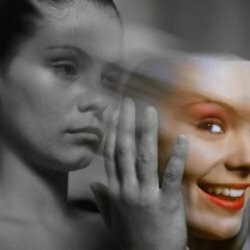Movement disorders in mental illness

The impact of mental disorders.
With various kinds of mental illness, there can be violations of complex motor behavior - the so-called psychomotor motor disorders. A severe focal brain lesion( eg, cerebral atherosclerosis) usually leads to paresis or paralysis. Generalized organic processes, such as brain atrophy( brain shrinkage in volume) are accompanied in most cases by lethargy of gestures and facial expressions, slowness and poverty of movements;Speech becomes monotonous, gait changes, general stiffness of movements is observed.
Mental disorders also affect psychomotor. Thus, manic-depressive psychosis in the manic phase is characterized by general motor excitement.
Some psychogenic disorders in mental illness lead to dramatically painful changes in psychomotorics. For example, hysteria is often accompanied by complete or partial paralysis of the limbs, reduced strength of movements, frustrated coordination. Hysterical seizure usually gives the opportunity to observe various expressive and protective facial movements.
For catatonia( neuropsychiatric disorder, which is manifested in the violation of voluntary movements and muscle spasms) are characterized as minor changes in motor skills( weak facial expressions, deliberate pretentious postures, gestures, gait, mannerisms), and vivid manifestations of catatonic stupor and catalepsy. The latter term refers to numbness or freezing, accompanied by a loss of ability to move arbitrarily. Catalepsy can be observed, for example, with hysteria.
All movement disorders in mental illness can be divided into three types.
Types of motor disorders.
- hypokinesia ( disorders that are accompanied by a decrease in motor volume);
- hyperkinesia ( disorders that are accompanied by an increase in motor volume);
- dyskinesia ( disorders in which involuntary movements are observed as part of usually smooth and well-controlled limb and face movements).
In the category of hypokinesia include various forms of stupor. Stupor is a mental disorder characterized by the oppression of all mental activity( movements, speech, thinking).
Types of stupor in hypokinesia.
1. Depressive stupor( called still melancholic numbness) manifests itself in immobility, depressed state of mind, but the ability to respond to external stimuli( reversals) persists;
2. Hallucinatory stupor occurs in hallucinations provoked by poisoning, organic psychosis, schizophrenia;With this stupor, general immobility is combined with mimic movements - reactions to the content of hallucinations;
3. Asthenic stupor manifests itself in indifference to everything and lethargy, unwillingness to answer simple and understandable questions;
4. Hysterical stupor is typical for people with a hysterical character( for them it is important to be in the spotlight, they are overly emotional and demonstrative in the manifestation of feelings), in a state of hysterical stupor the patient for a very long time lies without movement and does not respond to treatment;
5. Psychogenic stupor arises as a reaction of the body to a strong mental trauma;Such stupor is usually accompanied by increased heart rate, increased sweating, fluctuations in blood pressure and other disorders of the autonomic nervous system;
6. Cataleptic stupor( also called wax flexibility) is characterized by the ability of patients to stay in their pose for a long time.
Mutism ( absolute silence) is also referred to as hypokinesia.
Hyperkinesia.
Types of excitations for hyperkinesia.
1. Manic excitation caused by abnormally heightened mood. In patients with mild forms of the disease, behavior remains focused, although accompanied by an exaggerated loud and fast speech, the movements remain well coordinated. In severe forms of motion, the speech of the patient is not connected in any way, motor behavior becomes illogical.
2. Hysterical excitement, which is most often a reaction to the surrounding reality, this excitement is extremely demonstrative and intensifies if the patient notices attention to himself.
3. Gebefrenic excitement, which is a ridiculous, cheerful, meaningless behavior, accompanied by pretentious facial expressions, is characteristic for schizophrenia.
4. Hallucinatory excitation - a living reaction of the patient to the content of their own hallucinations.
The study of psychomotorics is extremely important for psychiatry and neurology. The patient's movements, his postures, gestures, manners are regarded as very significant signs for a correct diagnosis.



